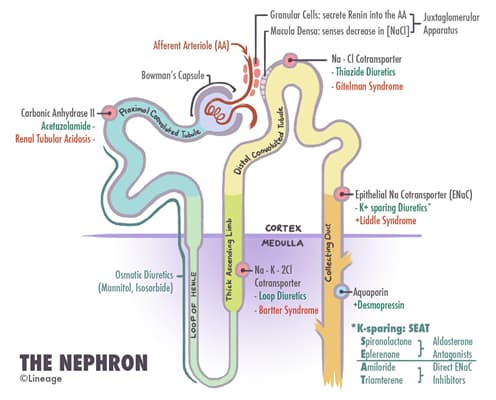Overview

Snapshot
- A 63-year-old man with a history of congestive heart failure presents with increased pedal edema and worsening orthopnea. He reports that he has been taking his lisinopril as prescribed and adhering to a low-salt diet. Physical exam shows 2+ pitting edema in the knees bilaterally and faint crackles on auscultation of the lungs. Left ventricular ejection fraction (LVEF) is measured by echocardiogram and found to be 33%. This is decreased from his last measurement of 38%. He is put on an additional medication. (Congestive heart failure exacerbations)
Spironolactone and Eplerenone
- Mechanism
- Clinical use
- hyperaldosteronism
- potassium wasting
- from loop or thiazide diuretics
- antiandrogenic
- treatment for female hirsutism
- Toxicity
- hyperkalemia
- can result in arrhythmias
- hyperkalemia
- eplerenone causes gynecomastia to a lesser extent
Triamterene and Amiloride
- Mechanism
- blocks ENAC in the cortical collecting duct, thereby leading to decreased sodium reabsorption
- indirectly reduces potassium secretion by creating a more positive luminal potential
- does not cause anti-androgen effects
- blocks ENAC in the cortical collecting duct, thereby leading to decreased sodium reabsorption
- Clinical use
- congestive heart failure (CHF)
- potassium wasting
- lithium-induced nephrogenic diabetes insipidus
- amiloride
- Toxicity
- hyperkalemia
- normal anion gap metabolic acidosis



